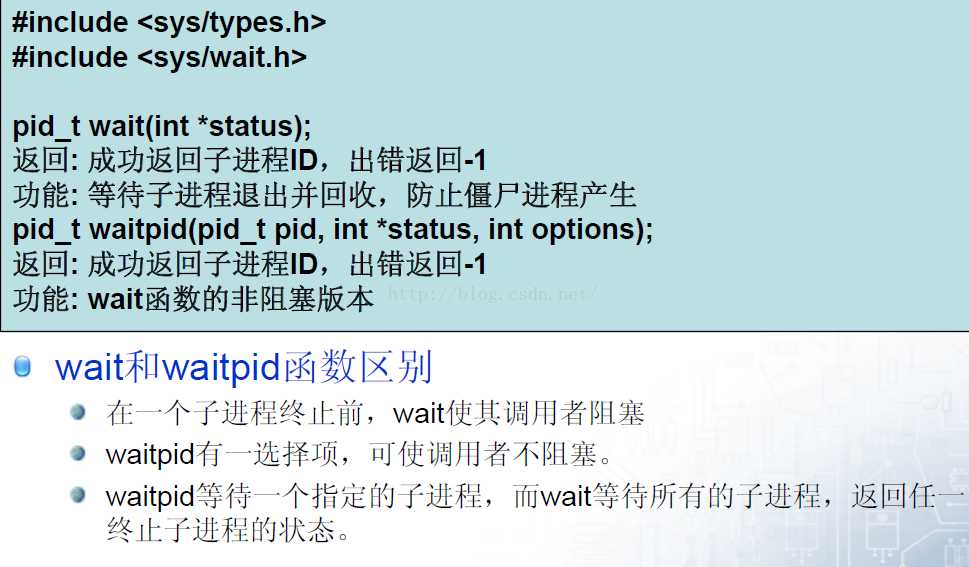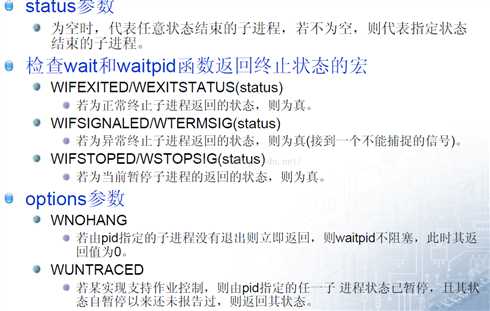2018-01-03@望京
关于fork()函数,Unix/Linux提供的fork()系统调用,fork()一次返回两次,
操作系统自动把当前进程(称为父进程)复制了一份(称为子进程),然后,分别在父进程和子进程内返回;
子进程永远返回 0,而父进程返回子进程的ID。
父进程结束时,子进程并不会随父进程立刻结束;同样,父进程不会等待子进程执行完。
- Python里fork()的使用
示例一
#!/usr/bin/python3
import os
print(‘Process (%s) start...‘ % os.getpid())
# Only works on Unix/Linux/Mac
pid = os.fork()
if pid == 0:
print(‘I am child process (%s) and my parent is %s.‘ % (os.getpid(), os.getppid()))
else:
print(‘I (%s) just created a child process (%s).‘ % (os.getpid(), pid))
####### 结果 #########
Process (25912) start...
I (25912) just created a child process (25913).
I am child process (25913) and my parent is 25912.
示例二
#!/usr/bin/python3
import os
import time
#创建子进程之前声明的变量
source = 10
try:
pid = os.fork()
if pid == 0: #子进程
print(‘I am child process (%s) and my parent is %s.‘ % (os.getpid(), os.getppid()))
#在子进程中source自减1
source -= 1
time.sleep(1)
else: #父进程
print(‘I (%s) just created a child process (%s).‘ % (os.getpid(), pid))
print(source)
time.sleep(2)
except OSError as e:
print("exception ",e)
####### 结果 ########
I (12807) just created a child process (12808).
10
I am child process (12808) and my parent is 12807.
9
- 服务器里的僵尸进程是怎么产生的?
参考:https://www.cnblogs.com/yuxingfirst/p/3165407.html
参考:http://blog.csdn.net/qq_20218109/article/details/52078076
参考:http://blog.51cto.com/forlinux/1422438
子进程结束后,但是父进程还没有结束的时候,子进程是出于Zombie状态的,这个需要父进程去收集子进程的信息释放子进程。
如果父进程结束了子进程没有结束,那么子进程就会寄托给pid为1的进程来管理。
给进程设置僵尸状态的目的是维护子进程的信息,以便父进程在以后某个时间获取,
这些信息包括子进程的进程ID、终止状态以及资源利用信息(CPU时间,内存使用量等等);
僵尸进程的产生示例
子进程先于父进程退出,同时父进程又没有调用wait/waitpid,则该子进程将成为僵尸进程。
#!/usr/bin/python3
import os
import time
try:
pid = os.fork()
if pid == 0: #子进程
print(‘I am child process (%s) and my parent is %s.‘ % (os.getpid(), os.getppid()))
else: #父进程
print(‘I (%s) just created a child process (%s).‘ % (os.getpid(), pid))
time.sleep(50)
print(‘%s end‘ % os.getpid())
except OSError as e:
print("exception ",e)
###### 结果 ######
I (19668) just created a child process (19669).
I am child process (19669) and my parent is 19668.
19669 end
19668 end # 这里sleep了50秒才打印
程序运行时,结合ps命令查看僵尸进程情况:
root@10.13.17.16[13:30:40]$ ps -A -ostat,ppid,pid,cmd | grep -e ‘^[Zz]‘ Z+ 19668 19669 [forkkk.py] <defunct> root@10.13.17.16[13:31:28]$ root@10.13.17.16[13:31:28]$ ps -A -ostat,ppid,pid,cmd | grep forkkk S+ 10582 19668 /usr/bin/python3 ./forkkk.py Z+ 19668 19669 [forkkk.py] <defunct> # 显然pid是19669,即子进程的id,子进程已经执行结束了,但是此时父进程19668还没有执行完。 S+ 17673 19678 grep forkkk root@10.13.17.16[13:31:30]$
- 如何避免出现僵尸进程呢/如何回收僵尸进程?
1. 信号方式
当子进程退出的时候,内核都会给父进程一个SIGCHLD信号,
所以我们可以建立一个捕获SIGCHLD信号的信号处理函数,在函数体中调用wait(或waitpid),就可以清理退出的子进程以达到防止僵尸进程的目的。
#!/usr/bin/python3
import os
import time
import signal
def childhandler(*args, **kwargs):
while True:
try:
result = os.waitpid(-1, os.WNOHANG)
except:
break
else:
print("Reaped child process %(pid)d, status is %(status)s" % {‘pid‘:result[0], ‘status‘:result[1]})
if __name__ == ‘__main__‘:
signal.signal(signal.SIGCHLD, childhandler)
print("Before the fork, parent PID is %s" % os.getpid())
pid = os.fork()
if pid:
print("Hello from the parent, the child PID is %s" % pid)
print("Parent sleeping 10 seconds ...")
time.sleep(10)
print("Parent sleep done.")
else:
print("Child sleeping 3 seconds ...")
time.sleep(3)
print("Child sleep done.")
###### 结果 ######
Before the fork, parent PID is 18998
Hello from the parent, the child PID is 18999
Parent sleeping 10 seconds ...
Child sleeping 3 seconds ...
Child sleep done.
Reaped child process 18999, status is 0
Parent sleep done.
os.waitpid() -1 表示等待主进程的所有子进程终止 os.WNOHANG 表示如果没有已经终止的子进程就立即返回
2. 父进程轮询检查子进程并回收
#!/usr/bin/python3
import os
import time
def recovery():
while True:
try:
result = os.waitpid(-1, os.WNOHANG)
#result = os.wait()
except:
break
else:
return result
if __name__ == ‘__main__‘:
print("Before the fork, parent PID is %s" % os.getpid())
pid = os.fork()
if pid:
print("Hello from the parent, the child PID is %s" % pid)
while True:
res = recovery()
time.sleep(0.5)
print(‘one loop...‘)
if res[0]:
print("Reaped child process %(pid)d, status is %(status)s" % {‘pid‘:res[0], ‘status‘:res[1]})
break
print("Parent run end...")
else:
print("Child sleeping 3 seconds ...")
time.sleep(3)
print("Child sleep done.")
###### 结果 ######
Before the fork, parent PID is 3391
Hello from the parent, the child PID is 3392
Child sleeping 3 seconds ...
one loop...
one loop...
one loop...
one loop...
one loop...
one loop...
Child sleep done.
one loop...
one loop...
Reaped child process 3392, status is 0
Parent run end...
轮询的方式没有办法很及时的处理僵尸进程(取决于轮询的时间间隔)。
注意:
- result = os.waitpid(-1, os.WNOHANG) 这种方式不会阻塞调用者。
- result = os.wait() 这种会阻塞调用者,导致不会进行轮询。


3. fork()两次/Python实现守护进程
父进程一次fork()后产生一个子进程,随后父进程立即执行waitpid(子进程pid, NULL, 0)来等待子进程结束,然后子进程fork()后产生孙子进程随后立即exit(0)。
这样子进程顺利终止(父进程仅仅给子进程收尸,并不需要子进程的返回值),然后父进程继续执行。
这时的孙子进程由于失去了它的父进程(即是父进程的子进程),将被转交给Init进程托管。
于是父进程与孙子进程无继承关系了,它们的父进程均为Init,Init进程在其孙子进程结束时会自动收尸,这样也就不会产生僵尸进程了。
详情见:http://blog.tangyingkang.com/post/2016/10/20/python-daemon/ *****
fork()两次不是必须的:https://segmentfault.com/a/1190000008556669 *****
import os
import sys
import atexit
def daemonize(pid_file=None):
"""
创建守护进程
:param pid_file: 保存进程id的文件
:return:
"""
# 从父进程fork一个子进程出来
pid = os.fork()
# 子进程的pid一定为0,父进程大于0
if pid:
# 退出父进程,sys.exit()方法比os._exit()方法会多执行一些刷新缓冲工作
sys.exit(0)
# 子进程默认继承父进程的工作目录,最好是变更到根目录,否则回影响文件系统的卸载
os.chdir(‘/‘)
# 子进程默认继承父进程的umask(文件权限掩码),重设为0(完全控制),以免影响程序读写文件
os.umask(0)
# 让子进程成为新的会话组长和进程组长
os.setsid()
# 注意了,这里是第2次fork,也就是子进程的子进程,我们把它叫为孙子进程
_pid = os.fork()
if _pid:
# 退出子进程
sys.exit(0)
# 此时,孙子进程已经是守护进程了,接下来重定向标准输入、输出、错误的描述符(是重定向而不是关闭, 这样可以避免程序在 print 的时候出错)
# 刷新缓冲区先,小心使得万年船
sys.stdout.flush()
sys.stderr.flush()
# dup2函数原子化地关闭和复制文件描述符,重定向到/dev/nul,即丢弃所有输入输出
with open(‘/dev/null‘) as read_null, open(‘/dev/null‘, ‘w‘) as write_null:
os.dup2(read_null.fileno(), sys.stdin.fileno())
os.dup2(write_null.fileno(), sys.stdout.fileno())
os.dup2(write_null.fileno(), sys.stderr.fileno())
# 写入pid文件
if pid_file:
with open(pid_file, ‘w+‘) as f:
f.write(str(os.getpid()))
# 注册退出函数,进程异常退出时移除pid文件
atexit.register(os.remove, pid_file)
- 扩展:Python中fork的代价

